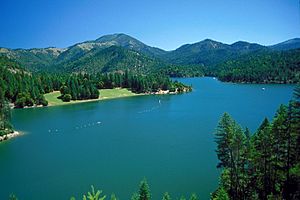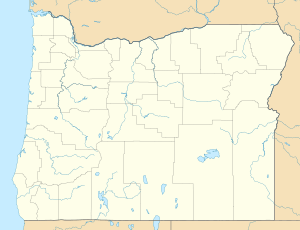Applegate River facts for kids
Quick facts for kids Applegate River |
|
|---|---|

Applegate Lake on the Applegate River
|
|
|
Location of the mouth of the Applegate River in Oregon
|
|
| Country | United States |
| State | Oregon, California |
| County | Siskiyou in California, Jackson and Josephine in Oregon |
| Physical characteristics | |
| Main source | Confluence of Butte Fork Applegate River and Middle Fork Applegate River Siskiyou Mountains, Siskiyou County, California 2,534 ft (772 m) 41°58′23″N 123°11′08″W / 41.97306°N 123.18556°W |
| River mouth | Rogue River about 6 miles (10 km) west of Grants Pass, Josephine County, Oregon 850 ft (260 m) 42°25′44″N 123°26′59″W / 42.42889°N 123.44972°W |
| Length | 51 mi (82 km) |
| Basin features | |
| Basin size | 698 sq mi (1,810 km2) |
The Applegate River is a beautiful river that flows for about 51 miles (82 km) in the United States. It is a tributary of the larger Rogue River in Oregon. The river helps drain an area of about 698 square miles (1,810 km²).
The Applegate River starts in northern California and quickly crosses into Oregon. It then flows northeast and northwest. Finally, it joins the Rogue River about 6 miles (10 km) west of Grants Pass. The river flows through the forested hills of the Siskiyou Mountains, which are located along the border between Oregon and California. The river is named after Lindsay Applegate, who explored the area in 1848.
Contents
Where Does the Applegate River Start and Flow?
The Applegate River begins high up in the Siskiyou Mountains in California. This area is part of the Rogue River–Siskiyou National Forest. The river's water comes from melting snow and natural springs. The Siskiyou area gets a good amount of rain and snow each year, usually between 17 to 40 inches (430 to 1,020 mm).
Journey Through Canyons and Valleys
The river then flows north through a deep canyon. It crosses the border into Oregon and picks up water from Elliot Creek. Elliot Creek starts in Oregon near Dutchman Peak but flows into California before joining the Applegate River.
Before the Applegate Dam was built, this area experienced big floods in 1964 and 1974.
Applegate Lake and Dam
The Applegate River is held back by the Applegate Dam in Oregon. This dam creates a large body of water called Applegate Lake, which covers about 988 acres (4 km²). The United States Army Corps of Engineers built the dam between 1974 and 1980.
The main reasons for building Applegate Lake were to provide water for irrigation (watering crops) and to help control floods in the Applegate Valley. A small community called Copper was covered by the lake's rising waters. It is now more than 100 feet (30 m) below the lake's surface.
Historic McKee Bridge
From the Applegate Dam, the river continues to flow north and slightly east. About 8 miles (13 km) from California, it flows under the historic McKee Bridge. This covered bridge was built in 1917. It was used by miners and loggers in the past.
The bridge was closed to cars in 1956 because it was unsafe. However, it was repaired in 1965 and 1985. Today, the McKee Bridge is open for people to walk across.
Meeting Other Creeks
A few miles past McKee Bridge, the Applegate River meets the Little Applegate River. Near Ruch, the Applegate River turns and flows northwest. It passes through the small communities of Applegate and Provolt. Near Provolt, the river moves from Jackson County into Josephine County.
Other creeks that join the Applegate River in this area include Thompson Creek and Williams Creek. Williams Creek was named after Captain Robert Williams. The town of Williams is also named after him.
From Williams Creek, the Applegate River turns west and flows through Murphy. Then it turns north through Wilderville.
Where the River Ends
The Applegate River finally flows into the Rogue River. This meeting point is about 6 miles (10 km) west of Grants Pass. It's just before the "Wild and Scenic" part of the Rogue River begins.
On average, the Applegate River empties about 720 cubic feet (20 m³) of water per second into the Rogue River. However, the amount of water can change a lot. In 1953, a very high flow of 47,500 cubic feet (1,340 m³) per second was recorded. In 1979, when Applegate Lake was being filled, the flow dropped to a very low 0.78 cubic feet (0.022 m³) per second.
What is the Applegate River Watershed?
The Applegate River watershed is the entire area of land where all the rain and snowmelt drain into the Applegate River and its smaller streams. This area covers about 698 square miles (1,810 km²).
Most of the land in the watershed is owned by the government. About 35 percent belongs to the United States Forest Service (as part of the Rogue River–Siskiyou National Forest). Another 35 percent is managed by the Bureau of Land Management. Private owners have about 20 percent of the land, and the remaining 10 percent is used for commercial forests.
Around 12,000 people live in the Applegate River watershed. They live in various small towns and on farms.
Plants and Animals of the Applegate River
The Applegate River watershed is home to many different kinds of plants and animals.
Common Trees and Shrubs
The most common trees you'll find here are Douglas fir and madrone. On the higher slopes, you can also see Oregon white oak and big-leaf maple trees.
Smaller plants, called Shrubs, grow beneath the trees. These include vine maple and manzanita.
Wildlife in the Area
Many animals live along the Applegate River. One special animal is the Siskiyou Mountains salamander. This salamander is an endangered species, which means it is at risk of disappearing forever. Another important animal is the spotted owl, which is considered "near threatened." This means its population is decreasing, and it could become endangered if not protected.
See also
 In Spanish: Río Applegate para niños
In Spanish: Río Applegate para niños


